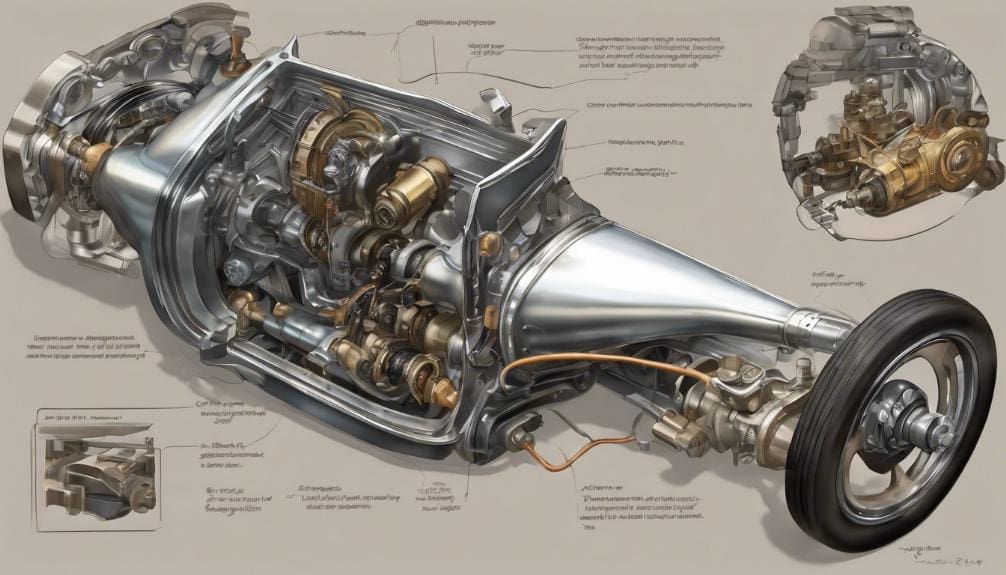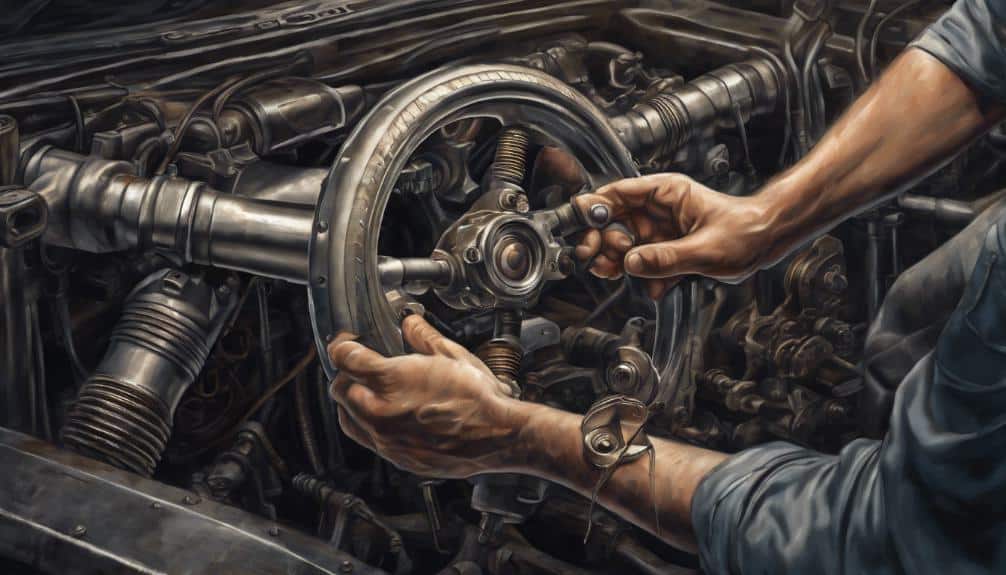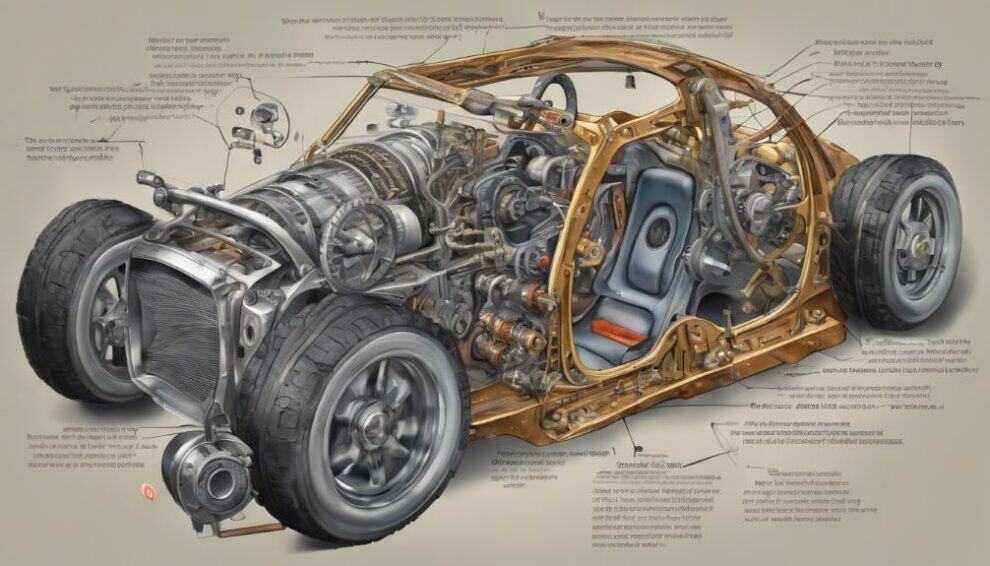To understand how your car’s steering gear operates, grasp that it transforms your steering wheel movements into wheel shifts.
With rack-and-pinion systems, a gear set in a tube directs this motion, delivering direct steering responses.
Power-assisted mechanisms employ cylinders and hydraulics for added steering strength, adjusting fluid pressure to suit different driving scenarios.
Key elements like the steering column, gear, and tie rods enable precise wheel control. Regular maintenance, such as fluid level checks and lubrication, guarantees peak performance.
By mastering these fundamentals, you enhance your driving experience and safety on the road.
Key Points
- Rack-and-pinion system provides direct and responsive steering feel.
- Power-assisted steering mechanisms enhance steering force with hydraulic operation.
- Components include steering wheel, rack and pinion gear, tie rods, and ball joints.
- Regular maintenance, fluid checks, and lubrication are crucial for optimal steering performance.
- Understanding gear ratio and components aids in troubleshooting and ensuring safe vehicle control.
Steering Gear Fundamentals

Understanding the basics of steering gear is essential for grasping how your vehicle responds to your steering commands.
The functionality of steering gear is pivotal in converting your steering input into the necessary movement of the wheels.
Advances in steering gear technology have led to more efficient systems, such as rack-and-pinion, recirculating ball, and electric power steering.
These advancements aim to provide drivers with smoother and more responsive steering capabilities.
When troubleshooting steering gear issues, it’s important to take into account the specific design and functionality of the mechanism based on your vehicle’s make and model.
Regular maintenance of the steering gear is crucial to ensure top performance and safe vehicle control.
Rack-and-Pinion System Overview
The rack-and-pinion steering system utilizes a gear set housed in a metal tube to convert steering wheel movements into linear motion for wheel turning.
This system is known for its direct and responsive steering feel, providing drivers with a more connected experience on the road.
The gear ratio in a rack-and-pinion system plays a vital role in determining how much the wheels turn in response to steering input.
A lower gear ratio results in quicker wheel movement, enhancing agility and responsiveness, while a higher gear ratio offers more stability at higher speeds.
One of the key advantages of rack-and-pinion steering is its precise handling, allowing for accurate control over the vehicle’s direction.
This system also reduces steering effort, making it easier for drivers to maneuver their cars, especially in tight spaces or during parking.
Whether equipped with power assistance or not, rack-and-pinion steering remains a popular choice for its lightweight design and reliable performance.
Power-Assisted Steering Mechanisms

Moving from the efficient rack-and-pinion system, power-assisted steering mechanisms utilize a cylinder, piston, and power steering lines to provide additional steering force.
These systems operate hydraulically, meaning they use fluid pressure to assist with steering.
The hydraulic operation allows for varying pressure based on turning force, speed, and load, providing the driver with enhanced control.
On top of that, power-assisted steering mechanisms incorporate electronic control to adjust the assistance level in real-time, ensuring top-notch steering performance under different driving conditions.
The benefits of power steering are significant, offering improved low-speed maneuverability and making highway driving easier and more comfortable.
By enhancing the driver’s steering capabilities, power-assisted steering systems contribute to an overall better driving experience.
The accurate and responsive steering assistance provided by these systems not only increases safety but also reduces driver fatigue, particularly during long journeys.
Essentially, power-assisted steering mechanisms represent a crucial component of modern vehicles, improving handling and maneuverability for drivers of all skill levels.
How Does Understanding Tune-Up Costs Relate to Mastering Car Steering Gear Operations?
Understanding Toyota tuneup costs is essential for mastering car steering gear operations. Proper tune-ups ensure that the engine is running smoothly, which directly impacts the performance of the steering gear. By understanding the costs associated with tune-ups, car owners can ensure their vehicle’s steering system operates at its best.
Common Steering System Components
Within the steering system of a vehicle, essential components such as the steering wheel, steering column, rack and pinion gear, tie rods, and ball joints work harmoniously to guarantee proper wheel alignment and responsive control.
The design of the steering wheel allows the driver to input steering commands easily, which are then transmitted to the steering column.
The rack and pinion gear assembly plays a vital role by converting the rotational motion of the steering wheel into linear motion to turn the wheels accurately.
Tie rods are instrumental in connecting the rack to the steering knuckles, ensuring precise control of the wheel alignment. Ball joints facilitate smooth pivoting of the tie rods, essential for proper movement and alignment of the wheels.
To maintain peak performance, regular ball joint maintenance is essential.
By ensuring that these common steering system components are in good condition, you can enhance the overall steering responsiveness and control of your vehicle.
Maintenance Tips for Optimal Performance

To keep your vehicle’s steering system operating at its best, prioritize regular maintenance for peak performance. Start by regularly checking power steering fluid levels to guarantee top-notch performance.
Proper lubrication is essential for smooth steering operation, especially in older cars with grease fittings that require periodic maintenance.
Then, scheduling preventative maintenance and inspections for alignments is vital to prevent premature wear on steering components.
Consider swapping threaded plugs for grease fittings as an upgrade to improve the longevity of your steering system.
It’s essential to promptly address any signs of wear and tear on steering components to maintain peak performance.
As an Amazon Associate we earn from qualifying purchases.










